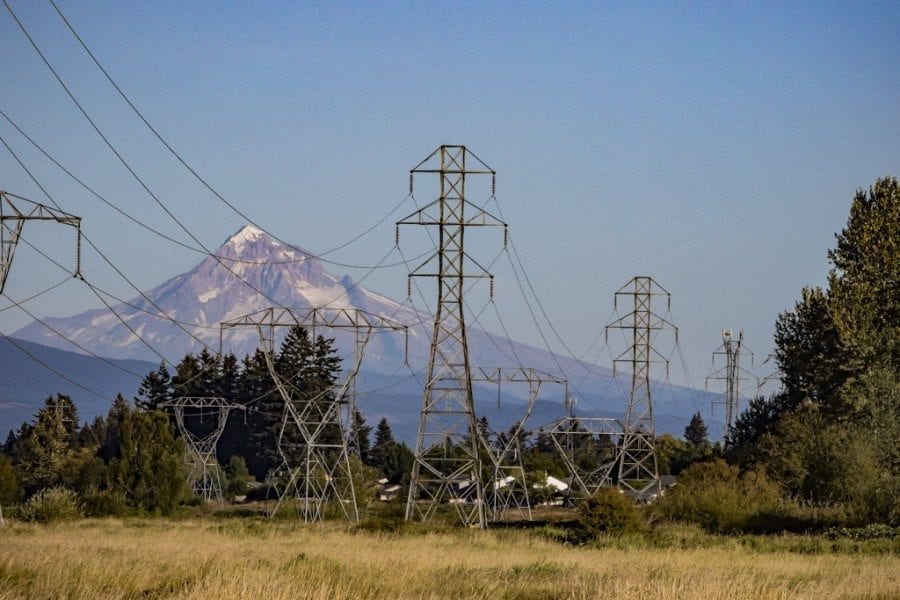PORTLAND, Ore. — The Bonneville Power Administration will not build the I-5 Corridor Reinforcement Project, a proposed 80-mile, 500-kilovolt transmission line that would have stretched from Castle Rock to Troutdale, Ore.
The decision, announced Thursday by Administrator Elliot Mainzer, caps a comprehensive public process and reflects BPA’s commitment to taking a more flexible, scalable, and economically and operationally efficient approach to managing its transmission system. The project, first announced in 2009, sought to address a reliability issue along a transmission corridor in southwest Washington and northwest Oregon that could lead to power outages.

Following a final environmental impact statement that was released in February of 2016, Mainzer promised the region that BPA would conduct additional analyses. BPA began an extensive review of financial forecasts, planning assumptions and commercial practices. It combined those results with findings of regional utilities and independent industry experts to address the underlying issue — managing congestion along the I-5 corridor while maintaining the potential for economic growth. Through this process, Bonneville determined it could meet its obligations to provide reliable, robust transmission service with a more innovative, flexible approach.
“Given the extensive work we’ve done in the past 15 months with regional partners and others, we are now confident that we can continue to meet the demands on the grid without building this 80-mile line in southwest Washington,” Mainzer said. “We will always make safe and reliable transmission service a priority. We also recognize a growing need to be flexible and agile in our business practices to create the greatest value to electricity ratepayers in the Northwest.”
The decision provides certainty for the more than 300 homeowners and landowners with property along the preferred route identified in the final EIS, and thousands of others who lived near other route alternatives.
“We are very thankful to the stakeholders and the public who actively engaged in this effort, and we appreciate their patience as we continued to look for how we could make the right investment at the right time under constantly evolving market conditions,” Mainzer said. “The scope, impact and increasing budget for this project became the catalyst for pushing us to reconsider our existing analytical processes, our commercial business practices and our implementation of federal reliability standards. The outcome is much bigger than a decision to build or not build this line: We are transforming how we plan for and manage our transmission system and commercial business practices regionwide.”
For example, in reviewing its project assumptions with regional utilities, BPA identified that it used a conservative approach to risk that went beyond industry standards. By modernizing its approach to develop better real-time visibility of the transmission system coupled with new tools to manage congestion during peak times, BPA may find additional transmission capacity that can be released for operational use or for sale.
Moving forward, BPA is identifying upgrades to existing transmission infrastructure and new business and commercial practices that will preserve the value of the system and meet customer demands. A technical conference will be convened within a month to discuss with our customers our new approach to managing congestion on our transmission grid.
Additionally, in the coming weeks, BPA will begin implementing a two-year pilot project that will provide targeted transmission congestion relief in the greater Portland-Vancouver area during peak periods of electric use in the summer. The pilot project should result in over 100 megawatts of flow relief along the most congested portion of the transmission corridor for four-hour blocks. This “non-wires” pilot is just one of many ideas Bonneville is initiating as part of its transformational approach to meeting customer needs.

Additional regional perspectives
U.S. Rep. Jaime Herrera Beutler: “I commend BPA for listening to and working with southwest Washington landowners, concerned citizens, community groups and municipalities throughout this process to assess our region’s energy needs and determine the best way to meet them.
“Frankly, BPA’s willingness to reverse course on the planned 500-kilovolt lattice-steel-tower transmission line that would have bisected our communities is somewhat unprecedented,’’ Herrera Beutler said. “It should serve as a model for other public entities who need to be willing to constantly reassess their decisions to make sure the community is at the center of them. I applaud their decision and the process they used to get to this point.
“BPA has assured me that it’s committed to meeting the present and future energy needs of our region through careful planning, system changes and innovation, and I stand ready to help meet those needs however I can,’’ Herrera Beutler said. “BPA’s work in providing carbonless energy to meet the needs of our community is vital.’’
Roger Gray, CEO, Northwest Requirements Utilities: “BPA has made a very difficult decision on the I-5 project. Adequate and reliable transmission is critical to customers, but so are affordable rates. Given the financial pressures BPA faces, I understand and support this decision. BPA’s customers will need to work with BPA to find alternative solutions such as the non-wires options already being explored by BPA. This will require innovative and creative thinking on the part of BPA and customers to find economic solutions to ensure reliability and affordability.”
Beth Looney, president and CEO, PNGC Power: “PNGC Power appreciates the complexity of the I-5 Corridor Reinforcement Project decision. Ensuring future economic growth and access to low-cost power resources are important to PNGC. We trust the administrator’s transmission plan will achieve these objectives. As demand for electricity grows, we look forward to partnering with BPA to find the most cost-effective and efficient transmission solutions.”
Scott Corwin, executive director, Public Power Council: “This was a huge undertaking for BPA with implications for utilities throughout the Northwest. We appreciate that BPA dug in and conducted a thorough review of cost-effective solutions. We look forward to working with Bonneville to ensure that new solutions meet BPA’s obligations to reliably deliver electricity to its core customers.”
The Bonneville Power Administration, headquartered in Portland, Ore., is a nonprofit federal power marketer that sells wholesale electricity from 31 federal dams and one nuclear plant to 142 Northwest electric utilities, serving millions of consumers and businesses in Washington, Oregon, Idaho, western Montana and parts of California, Nevada, Utah and Wyoming.
BPA delivers power via more than 15,000 circuit miles of lines and 261 substations to 475 transmission customers. In all, BPA markets about a third of the electricity consumed in the Northwest and operates three-quarters of the region’s high-voltage transmission grid. BPA also funds one of the largest fish and wildlife programs in the world, and, with its partners, pursues cost-effective energy savings and operational solutions that help maintain affordable, reliable and carbon-free electric power for the Northwest.
For more information, go to www.bpa.gov.
Information provided by Bonneville Power Administration.




